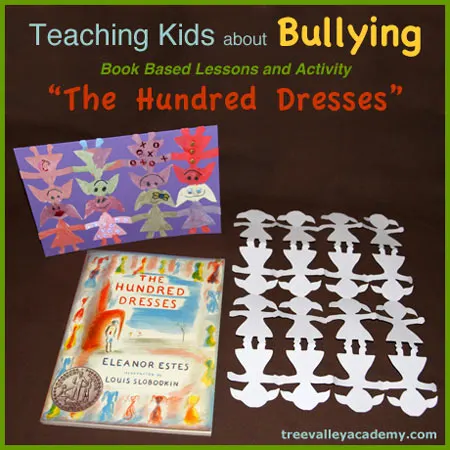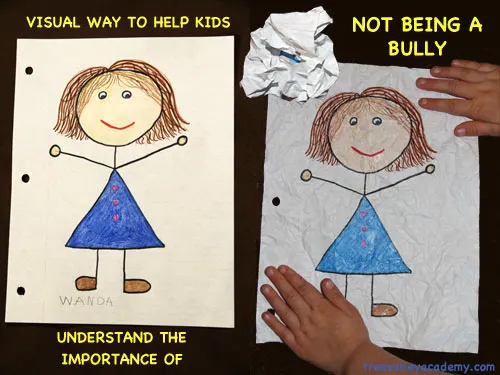Bullying is a hot topic in schools and has become an important subject even in our home school.

Since I’ve become a parent, I have come to realize just how young bullying starts. Bullying is not just reserved for older school aged children. Kids can form clicks, exclude and be mean to other children at quite a young age. In my experience, I would say at the 4 years old age group was when I started becoming aware of the issue.
I have seen my young daughter, at times, take on the role of the bully and has also been bullied. So this was an important issue for me to address with her, as I don’t want her to have either role.
Of course, at this age they don’t have the skills to understand how their actions might hurt someone else, or what to do if they are being bullied, so I felt it very important that I try to educate my daughter about the subject.
The Hundred Dresses
“The Hundred Dresses” book won the Newbery Honor in 1945. This means it didn’t win the Newbery Medal that year but was one of the runners-up.
“The Hundred Dresses” is said to be for children in Grades 1-6. I read it aloud to my 5 year old and I will say it was a little advanced for her age level. While she did understand the story, I think this would be a great book for a Grade 3 level curriculum.
It’s an illustrated chapter book. Most pages have black and white sketches with random colour added. The images helped keep my daughter’s interest, and we also had frequent discussions throughout our reading to make sure she understood the story as it was happening.
The book was great for exploring bullying from different ones involved:
- the bully
- the bystanders
- the person being bullied.
I wanted to explore all 3 angles with my daughter.
Lessons from the book “100 Dresses”
The Bully
First we verbally analyzed Peggy, the character in the book who initiates the bullying. Peggy was the most popular kid in school. She was pretty and had a lot of nice clothes.
We learned what a bully is and how someone can be a bully even if they are not physically hurting someone. Some questions we answered together were: In what ways did Peggy bully Wanda? Why do you think she did so? What did the other students actually think about her bullying?
Then I asked my daughter if there was anything she might have done to someone else that they did not like her doing. I brought up the time she reached over and messed up a kid’s hair in her swimming class.
“Do you think he liked it when you did that, or didn’t like it?”
“So if we think someone won’t like something, do you think we should do it or not do it?”
She understood the point, and hopefully the next time before she impulsively acts, she will stop and think.
The Bystander
Next our discussion turned to the main character of the book, Maddie. Maddie doesn’t initiate the bullying but she participates in that she doesn’t say or do anything to stop it. She knows it wrong, but doesn’t know what to do. So we talked about:
- different ideas my daughter could do if she saw someone else being bullied
- the consequences Maddie had for not doing anything about the bullying
- the choice the bystander has – they can choose to support the bully, pretend they don’t see what’s happening, or help the victim
- peer pressure, and how even if everyone is doing something we know is wrong, we should still do what we know is right.
The Bullied
Finally we talked about Wanda, who wore the same blue dress to school each day, had a different culture, a funny last name, was very poor, and stayed to herself most of the time. Wanda was a girl who was being bullied.
We referenced the article What If I’m Being Bullied? We learned that loners; youths who are perceived as being different; and youths who lack self-confidence are the easiest targets for a bully. With that in mind we discussed:
- Why was Wanda an easy target for a bully?
- Was she that different from the other girls? We drew a Venn diagram to illustrate some of the differences and similarities between all the girls.
- How do we think the bullying made Wanda feel? (a great opportunity to practice empathy)
Visual Aid to Understand Long Lasting Effects of Bullying
To help illustrate the lasting effects of bullying, and how it affects the victim, I gave my daughter a paper and asked her to draw a picture of Wanda. I drew one at the same time.
Afterwards, I asked my daughter to name some of the mean things Peggy and the other participating girls did to Wanda. She was a bit short of answers so I helped her out. Every time one of us came up with a way they weren’t nice to Wanda, I crinkled up my paper a little – I knew better than to try this with my daughter’s drawing. At the end it was a crinkled mess.
Then I told her “Wanda had to change schools, maybe at the new school the kids are nice to her. How do you hope the kids at the new school act towards Wanda? What kinds of things would nice kids do to make her feel welcomed and included?“
This time she was full of ideas. Every idea, I unfolded my drawing a little until it was completely unfolded. I let my daughter do her best to try to smooth out the wrinkles.
Then I asked her “so the kids in Wanda’s new school are nice to her and that’s so great, but did the damage the bullies did to her in her first school disappear?” It was a great visual way for her to see the importance of never bullying someone or participate in bullying as the damage is almost impossible to undo.
It’s not all lessons and no play. We also did a fun art activity to go with the book “The Hundred Dresses”.
See post The Hundred Dresses Activity – Paper Doll Chain Card for detailed instructions on making a handmade card with a 16 doll paper doll chain.



Sandy Sandmeyer
Sunday 18th of October 2015
Thank you so much for sharing your post with us at the #AnythingGoes Link Party! See you next week.
Emma
Thursday 8th of October 2015
I love your visual way of showing how the effects of bullying can't be undone. That's a hard thing to teach kids but I think your way would have a powerful impact!
Jenn Roberts
Wednesday 7th of October 2015
Such an awesome lesson that should be taught in every single home! Thank you so much for sharing this and for linking up on my blog party!
Branson
Monday 5th of October 2015
I love the visual you used! This is an important issue for sure!
Wendy
Sunday 4th of October 2015
I enjoyed this book. I, too, read it to my daughter when she was probably too young to really get the full meaning. She liked the book, but I think the real message was lost on her (she was around 6). You did a very thorough review here! #AnythingGoes